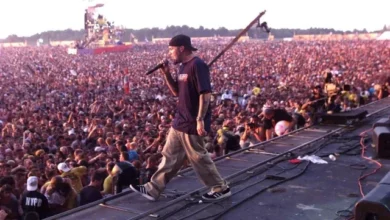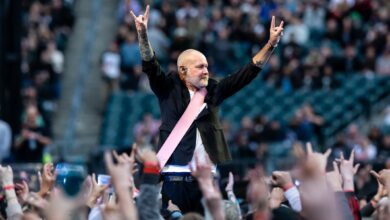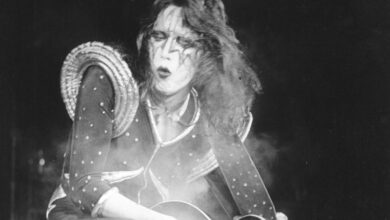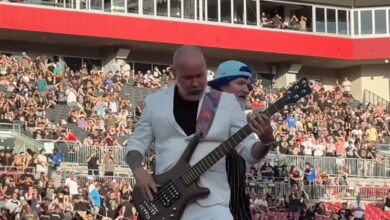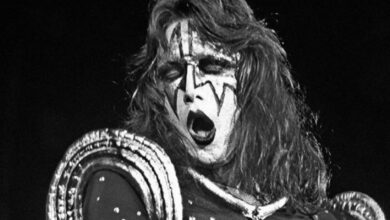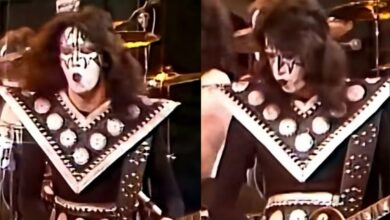Limp Bizkit’s Explosive “Break Stuff” Ignites Lollapalooza Chile — A Fiery Performance Now Remembered in the Wake of Sam Rivers’ Passing
Lollapalooza Chile 2024 had already been a furnace by the time Limp Bizkit walked onstage at Parque Bicentenario de Cerrillos, but the temperature jumped a few more notches the second the opening riff of “Break Stuff” hit. The band didn’t tease it; they detonated it, using the song as a starter pistol rather than a closer, and the festival grounds reacted like a shaken soda can finally popped. Pro-shot footage later confirmed what everyone in Santiago felt in real time: this was a crowd built to bounce, and a band intent on giving them a reason.
Starting with “Break Stuff” at a major festival is a bold choice even for Limp Bizkit, whose live shows thrive on chaos shaped into catharsis. It meant skipping the warm-up jog and sprinting directly into the mosh-pit’s center, trusting muscle memory and showcraft to keep everything on the rails. That trust was well placed. Fred Durst stalked the lip of the stage like a conductor who’d swapped baton for baseball cap, pacing the tempo with hand chops and eye contact as the first chorus blew the field wide open.
Part of what made the moment work was how locked-in the band sounded from the downbeat. Wes Borland’s guitar tone arrived serrated but controlled, slicing through the Chilean air with the kind of precision you don’t often associate with mayhem. John Otto put a square jaw on the groove, landing backbeats like punctuation marks. DJ Lethal’s scratches added the familiar, elastic snap between verses, the secret seasoning that keeps the arrangement bouncing. When you run “Break Stuff” first, your rhythm section has to be bulletproof; in Santiago, it was Kevlar.
That decision also reframed the entire set. Rather than build toward the hit, Limp Bizkit treated “Break Stuff” as a fuse and let the explosion illuminate everything that followed. The sequence that came in its wake—“Rollin’ (Air Raid Vehicle),” “Nookie,” “My Way,” and the crowd-sung curveball covers—felt like chapters in a story that had already started mid-action. The pacing echoed the published set list from the festival, but in person it landed with the inevitability of a greatest-hits victory lap, each transition sticking like a wrestling suplex.
Lollapalooza Chile is a sprawling, multi-stage beast, and timing matters. Limp Bizkit slotted into that golden hour when the sun is lowering and the sound carries, the moment festivals vintage into cinematic. Setlist logs place the group on the 15 March lineup at Parque Bicentenario de Cerrillos, part of a bill that flipped stages like pulsing circuit boards throughout the evening. In that context, hitting the ground with maximum voltage wasn’t just stylistic—it was strategic, a way to claim the field before fans dispersed to the next must-see.
The crowd turned into a living topography of motion—peaks of circle pits, valleys of phone-lit singalongs, and a long, rolling plain of pogoing bodies. Clips that surfaced after the show captured the festival-wide roar during the hook, a sound equal parts nostalgia and renewed adrenaline. You could hear it in the way thousands of voices bit into the consonants—every “I think you better quit” delivered like a hometown chant—and you could see it in the grins exchanged between total strangers who suddenly remembered the lyrics they’d been yelling in cars since 1999.
For all the ferocity, the performance had shape. Borland’s art-house menace—tones that seem to bend around corners—gave the choruses teeth, but he also left space for the verses to swagger. Otto drummed like a veteran who understands that head-nodding is as crucial as head-banging, dialing in pocket over fireworks. Durst played emcee and instigator, a ringmaster’s grin always threatening to become a dare. It was the classic Bizkit chemistry, the same recipe that made these songs festival-proof across decades, reintroduced to a new latitude and greeted like returning family.
One reason the opener landed so hard is that the band treated dynamics like a weapon. The verses crouched; the pre-chorus coiled; the chorus pounced. On the field, you could feel the air compress when the guitars dropped out, a whole city block’s worth of anticipation collapsing to a needlepoint before the band slammed back in. The pro-shot camera work caught those pivots cleanly—quick cuts to hands, faces, and the oscillating horizon of the pit—reminding everyone later why Limp Bizkit remains, for better and for bedlam, one of the most reliable ignition switches in festival history.
“Break Stuff” also set up a clever narrative inversion later. Plenty of artists save their hardest punch for last; Bizkit used theirs to loosen every joint in the park so the rest of the set could move with ease. When “Behind Blue Eyes” arrived, you could feel the collective exhale, that mid-set recalibration that makes the heaviness heavier when it returns. And return it did—“My Generation,” “Faith,” and “Take a Look Around” surged like old friends who haven’t lost their sprint speed, just learned better footwork. The sequence mirrored published reports from the night, but in person it felt custom-built for Santiago.
Lollapalooza Chile 2024 wasn’t just a victory lap; it was a statement about endurance. The festival itself has become a Southern Hemisphere barometer for which sounds still move masses, and Limp Bizkit proved their readings remain accurate. On a bill full of pop maximalists and electronic heavies, a late-’90s/early-’00s juggernaut won a modern crowd without apology, rewiring any doubts with a simple argument: a huge hook plus a heavier groove still wins the day when the band is locked, loud, and smiling like they know a secret.
In the months after, multiple angles of the performance circulated online, each one a new vantage point on the same ecosystem of energy. Wide shots showed the Santiago skyline quivering to the chorus; pit-level videos caught the whirl of elbows and grins; side-stage clips revealed the little nods musicians exchange when everything is clicking. The official-looking uploads crystallized the memory in HD, but even the grainy phone captures sold the essential truth: the song that once defined an era still detonates in any language.
The set also invited a reassessment of Limp Bizkit’s core appeal. Strip away the memes and the discourse, and you’re left with a band that understands crowd physics—where to leave a gap, when to hit in unison, how to cue an entire field with a single hand wave. Durst’s stagecraft is showman-simple, but it works because the band underneath is so disciplined. Borland paints in negative space. Otto and the low end—anchored historically by Sam Rivers—keep the chassis welded. Lethal flicks switch after switch until the whole thing hums. That architecture makes mayhem feel safe enough to join.
Which brings a bittersweet coda to revisiting this performance now: the recent passing of founding bassist Sam Rivers at the age of 48. News of his death, announced by the band in October 2025, rippled through rock media and fan communities, framing earlier triumphs like Santiago with fresh poignancy. In countless live moments over three decades, Rivers supplied the ballast—an unshowy but crucial gravity that made Bizkit’s bounce hit harder. Remembering Lollapalooza Chile through that lens sharpens the contrast: the joy of the groove, now edged with absence.
Coverage from major outlets captured both the shock and the gratitude: tributes called him the “heartbeat” of the group, a musical presence whose steadiness let the circus fly. No cause of death was disclosed at the time of reporting, but the unanimity of the eulogies said enough about his impact—on the band’s sound, on their internal chemistry, and on fans who learned to move a certain way because of the lines he laid down. Rewatching “Break Stuff” from Santiago, you can feel how the low-end architecture he helped define still carries the roof.
All of which makes the Chile performance feel not just explosive, but enduring. It’s a document of a unit in fighting trim—musicians who know exactly where the song lives and how to drive it like a stolen car without stalling the engine. In a festival world where novelty often outruns nuance, Limp Bizkit reminded everyone that groove, grit, and a chorus you can shout with your whole torso are renewable resources if you keep the machine maintained and the intent clear.
There’s a reason fans and festival lifers came away buzzing that weekend: this band aged like a bottle of fine wine. God damn, they sounded and looked great. The years have added confidence, timing, and an almost athletic economy—no wasted motion, no filler between detonations. Lollapalooza Chile 2024 didn’t recast Limp Bizkit as something they’re not; it showcased what they’ve always been at their best: a live act that can turn a field into a single, surging organism inside the first four bars of “Break Stuff,” then keep it breathing in rhythm until the house lights blink.
